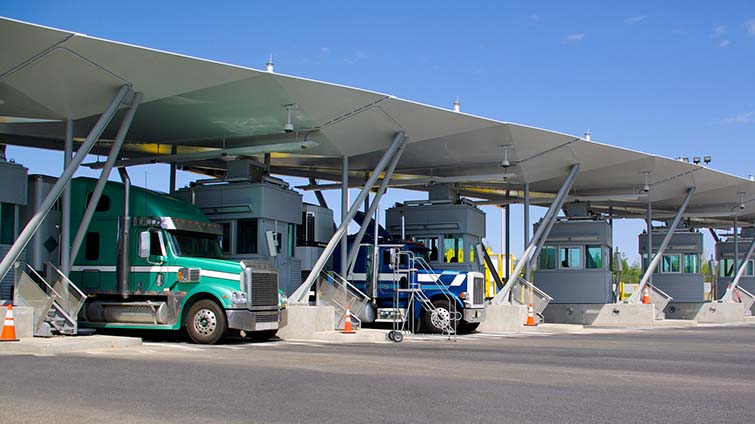Mexico trade surges amid policy shifts and tariff pressures
Published: Thursday, November 06, 2025 | 08:00 am CDT
U.S.–Mexico
Trade Trends
Mexico’s trade with the United States continues to show resilience, despite mounting industrial and policy changes. September marked a record-setting month for exports, which grew 13.8% year over year (y/y), the highest in 14 months. This was driven almost entirely by non-automotive manufacturing. At around 40%, Mexican exports have a high level of U.S. content—a benefit in an environment of ubiquitous U.S. tariffs.
The largest export gains were in machinery and special equipment, including computers and technology (76.2%); metallurgical mining products (12.1%); electrical and electronic equipment and devices (9.9%); and scientific equipment (8.9%).
This strength contrasts with the automotive sector, where exports to the United States fell 7.2% y/y. Total auto exports experienced a slight decline of 0.2%.
Laredo remains the busiest port, but El Paso is gaining traction as shippers seek alternatives for machinery and high technology produced in Chihuahua, the top exporting state in Mexico and the leader state in computer equipment exports.
The heavy-duty vehicle industry saw exports plunge nearly 60% in September ahead of the 25% U.S. tariff on medium and heavy-duty trucks that went into effect November 1. About 70% of heavy-duty trucks manufactured in Mexico are shipped to the United States. The industry previously experienced growth, with exports increasing 17.3% y/y in August.
The sudden reversal in September reflects the immediate impact of policy uncertainty. Light vehicle production also declined 6.1% y/y in September, with total vehicle output down 0.3% from the same period in 2024.
Mexico’s strategic importance in U.S. trade is expanding largely at the expense of China. Since 2018, Mexico has captured 24% of the U.S. import market share previously held by China. Still, the automotive sector faces headwinds ahead of the 2026 review of the U.S.-Mexico-Canada Free Trade Agreement. Industry leaders warn that stricter rules of origin, particularly regarding Chinese components, could complicate compliance and weaken competitiveness unless adjustments are made during negotiations.
Rates and capacity
While overall cross-border trucking rates remain stable, pressures on specialized capacity and manufacturing inputs require close monitoring. Mexico’s cargo truck fleet declined 0.2% year over year, marking the first contraction in more than a decade. More than half of active trucks are over 20 years old, raising long-term concerns about capacity reliability and modernization as 2026 approaches.
Policy updates
Effective December 9, 2025, all importers into Mexico must submit the Electronic Declaration of Value (Manifestación de Valor) through VUCEM before customs clearance. It must include a sworn statement explaining how the shipment’s value was determined, along with supporting documents such as invoices, freight and insurance details, contracts, and proof of payment. Importers will need their e.firma to access VUCEM, so early coordination is strongly recommended to avoid clearance delays.
Disruptions
Beyond policy challenges, cross-border shippers are contending with frequent, unpredictable events that disrupt freight flows. A recent example is the nationwide farmers strike in Mexico in late October that blocked major highways across at least 17 Mexican states, including Guanajuato, Jalisco, Michoacán, and the State of Mexico as well as key corridors such as the Macro Libramiento of Guadalajara, Guadalajara–Colima, and Morelia–Guadalajara.
Protests periodically ease when agreements are met, but reprieves have been temporary in nature. This volatile situation has made it difficult for carriers and shippers to plan around, as risks of being stuck on a highway for extended periods of time include running out of fuel and health risks to drivers as well as simply late deliveries.
Even after a blockade concludes, it takes some time for the backlog of freight to be cleared and for capacity to normalize. If protests continue, downstream issues could impact freight into the United States.
These disruptions highlight the fragility of cross-border supply chains and the importance of contingency planning. Even when trade fundamentals are strong, localized protests, weather events, and infrastructure bottlenecks can halt freight movement without warning. Agility and proactive risk management remain essential for maintaining reliable cross-border logistics.
U.S.–Canada
Canada’s freight market remains steady overall, but with much attention focused on the United States’ new 25% tariffs on heavy-duty trucks and parts that went into effect November 1. The impact will likely be felt more in Mexico, but some Canadian manufacturers could also experience disruptions. One manufacturer, which produces large commercial trucks and operates divisions in Canada, laid off workers at its Ste-Thérèse, Quebec, plant in August and more could follow.
Further cutbacks like this would impact goods and parts shipments flowing inbound as well as product volumes outbound. Regional capacity could be volatile as shippers adjust their freight flows and carriers adjust their assets in response to demand.
Capacity tightened briefly during the Diwali period, particularly for southbound freight, as many South Asian drivers took time off. With the holiday now over, operations have largely returned to normal. Some imbalance remains, but overall conditions have improved.
As winter approaches, shippers should anticipate similar volatility driven by upcoming holidays and weather-related challenges. Cold conditions can make roads difficult or even impassable, so close attention to road conditions, closures, and tire or chain requirements will be essential for effective route planning and maintaining on-time transit for shippers and carriers.
 Download slides
Download slides